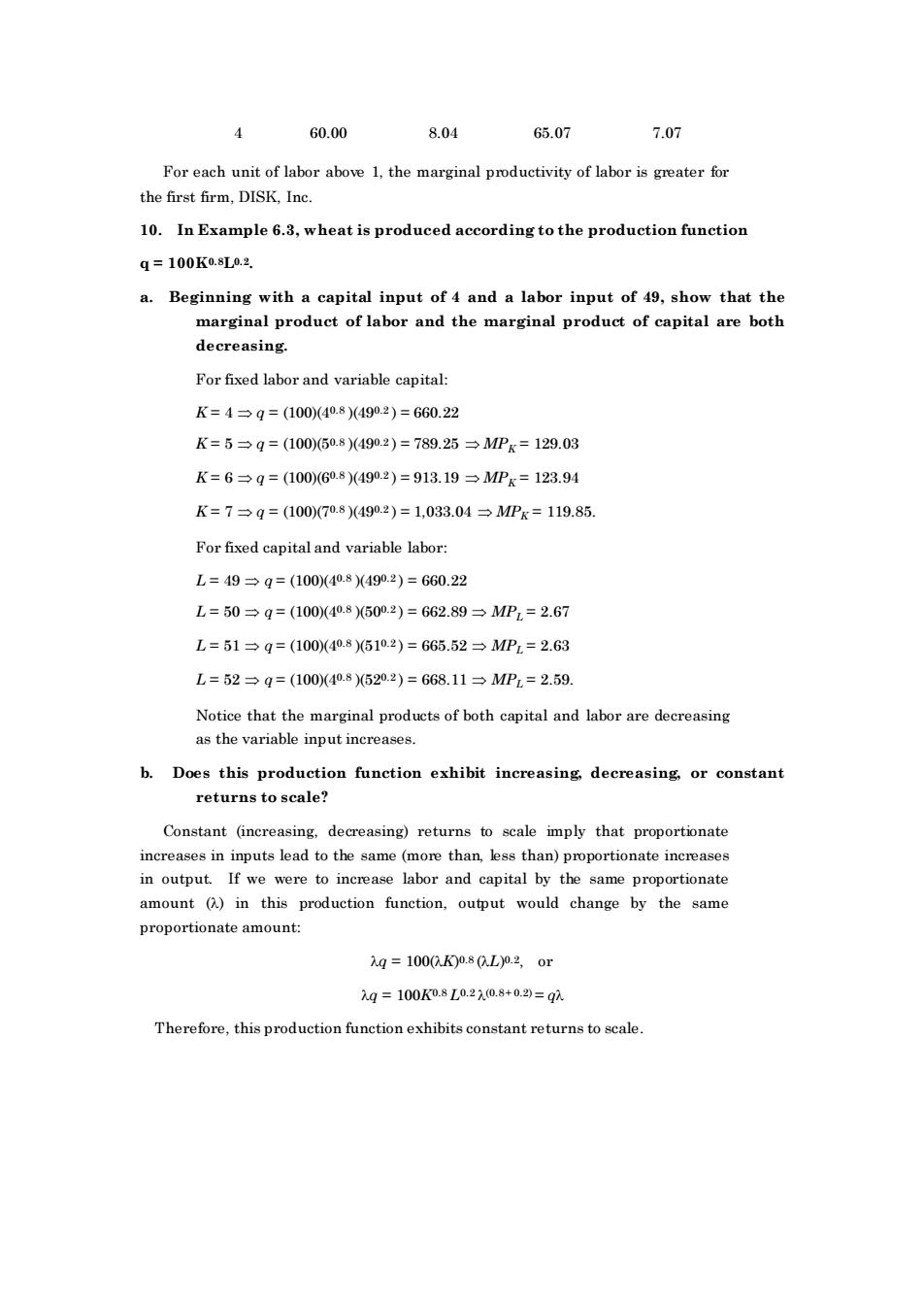正在加载图片...

4 60.00 8.04 G5.07 7.07 Forach unit of labor above 1.the of labor isgeaterfor the first firm,DISK,Inc. 10.In Example 6.3,wheat is produced according to the production funetion q=100K0.sLo.2 a.Beginning with a capital input of 4 and a labor input of 49,show that the marginal product of labor and the marginal product of capital are both decreasing. For fixed labor and variable capital K=4→0=(100)(40.8)(490.2)=660.22 K=5→g=(100)60.8)(490.2)=789.25→MPx=129.03 K=6→g=(100)608)(490.2)=913.19→MPx=123.94 K=7→g=(10070.8)(4902)=1,033.04MPx=119.85 For fixed capital and variable labor: L=49-g=(100408X499.2)=660.22 L=50→g=(100(40.8X500.2)=662.89→MP2=2.67 L=51=g=(10040.8)5102)=665.52=MP,.=2.63 L=52→q=(100(40.8)520.2)=668.11→MP=2.59. Notice that the marginal products of both capital and labor are decreasing as the variable input increases Does this production function exhibit increasing,decreasing,or constant returns to scale? Constant (increasing.decreasing)returns to scale imply that proportionate increases in inputs lead to the same (more than.less than)proportionate increases in output.If we were to increase labor and capital by the same proportionate amount ()in this production function,output would change by the same proportionate amount q=1000K0.80L0.2,or 7=100K8L02元8+02=g Therefore,this production function exhibits contant returns4 60.00 8.04 65.07 7.07 For each unit of labor above 1, the marginal productivity of labor is greater for the first firm, DISK, Inc. 10. In Example 6.3, wheat is produced according to the production function q = 100K0.8L0.2. a. Beginning with a capital input of 4 and a labor input of 49, show that the marginal product of labor and the marginal product of capital are both decreasing. For fixed labor and variable capital: K = 4 q = (100)(40.8 )(490.2 ) = 660.22 K = 5 q = (100)(50.8 )(490.2 ) = 789.25 MPK = 129.03 K = 6 q = (100)(60.8 )(490.2 ) = 913.19 MPK = 123.94 K = 7 q = (100)(70.8 )(490.2 ) = 1,033.04 MPK = 119.85. For fixed capital and variable labor: L = 49 q = (100)(40.8 )(490.2 ) = 660.22 L = 50 q = (100)(40.8 )(500.2 ) = 662.89 MPL = 2.67 L = 51 q = (100)(40.8 )(510.2 ) = 665.52 MPL = 2.63 L = 52 q = (100)(40.8 )(520.2 ) = 668.11 MPL = 2.59. Notice that the marginal products of both capital and labor are decreasing as the variable input increases. b. Does this production function exhibit increasing, decreasing, or constant returns to scale? Constant (increasing, decreasing) returns to scale imply that proportionate increases in inputs lead to the same (more than, less than) proportionate increases in output. If we were to increase labor and capital by the same proportionate amount () in this production function, output would change by the same proportionate amount: q = 100(K) 0.8 (L) 0.2, or q = 100K0.8 L0.2 (0.8 + 0.2) = q Therefore, this production function exhibits constant returns to scale